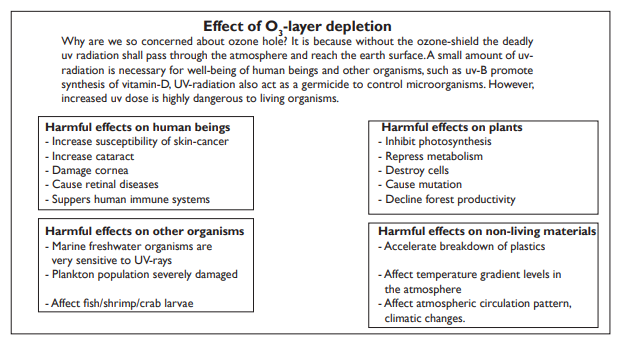Formation of ozone layer
- Ozone (O3) is a highly reactive molecule containing three oxygen atoms. The upper part of the earth’s atmosphere, between 10 and 50 km above the earth surface called stratosphere contains a thin layer of ozone. This ozone layer serves as a natural filter for blocking deadly incoming UV radiation from the sun.
Causes of ozone layer depletion
- Ozone (O3 ) layer can be destroyed both by natural and man-made causes
i) Natural causes: A number of naturally occurring substances destroy stratospheric ozone. Most important of these compounds are: Hydrogen oxide (HOx), Methane (CH4 ), Hydrogen gas (H2 ), Nitrogen oxides (NOx ). Chlorine monoxide (ClO); during volcanic eruptions, significant amount of chlorine may be released in the stratosphere. Tiny particulate matter in the stratosphere, known as stratospheric aerosols, may also lead to ozone destruction.
ii) Human activity related causes: Any event, which release chlorine atoms into the atmospheric, can cause severe ozone destruction, because chlorine atoms in the stratosphere can destroy ozone very efficiently. Most damaging among such agents are human made chlorofluorocarbons (CFCs), which is widely used as refrigerants and to pressurize sprays cans.

Measures to prevent ozone (O3 ) layer depletion
- Global awareness and action on the part of world community in the form of Helsinki (1989), Montreal (1990’s) conventions and protocol have had some important success on this front. A complete ban on the use of CFCs and other ozone destroying chemicals is recommended. Further, use of HCFCs (Hydrochloric fluorocarbons) as a substitute for CFCs is being recommended on temporary basis because HCFCs are relatively less damaging to ozone layer as compared to CFCs, but they are not completely ozone safe.

